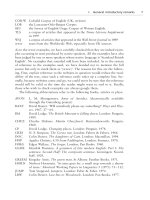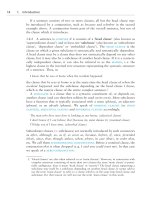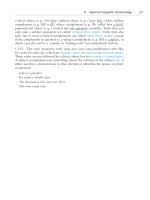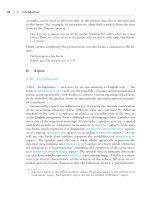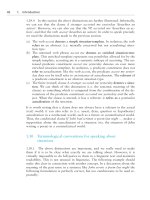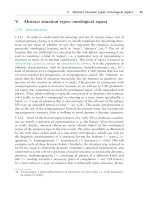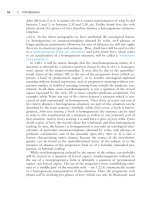The grammar of the english verb phrase part 9 pot
Bạn đang xem bản rút gọn của tài liệu. Xem và tải ngay bản đầy đủ của tài liệu tại đây (76.88 KB, 7 trang )
V. Abstract situation types: ontological aspect 49
V. Abstract situation types: ontological aspect
1.33 Introduction
1.33.1 In order to understand the meaning and use of certain tenses and of
(non)progressive forms, it is necessary to classify templates for describing situa-
tions on the basis of whether or not they represent the situation as having
particular ontological features, such as ‘static’, ‘durative’, etc.
18
The set of
features that are attributed to a situation by the verb phrase representing it are
said to constitute a kind of ‘aspect’, i. e. a particular way of representing a
situation in terms of its internal constituency. This kind of aspect is known as
Aktionsart, lexical aspect or ontological aspect. It is the expression of
inherent characteristics, such as (non)staticness, (non)durativeness, etc., of a
kind of situation as it is linguistically represented by a verb phrase that has not
yet been marked for progressive or nonprogressive aspect. (By ‘inherent’ we
mean that the kind of situation necessarily has the features in question, irre-
spective of the context in which it is used.) The proviso in connection with
(non)progressive aspect is necessary because, as we will see in 1.49, grammati-
cal aspect may sometimes overrule the ontological aspect of the unmarked verb
phrase. Thus, while walking is typically conceived of as dynamic, the sentence
John walks to work is interpreted as referring to a state (more specifically, a
habit, i. e. a type of situation that is characteristic of the referent of the subject
NP over an extended period of time Ϫ see 1.23). This static interpretation is
due to the use of the nonprogressive form of the present tense: the correspond-
ing progressive sentence John is walking to work denotes a dynamic situation.
1.33.2 Some of the lexical-aspect features of a verb, VP or predicate constitu-
ent are purely a question of representation (e. g. the feature ‘slow movement’
in walk slowly), whereas others are more closely linked to the ontological
status of the situation type in the real world. The latter possibility is illustrated
by the verb drive (when used as a one-word verb phrase), which can only be
the linguistic representation of a situation having the features [Ϫ static], [ϩ
agentive], [ϩ homogeneous], [Ϫ transitional], [ϩ durative], [Ϫ telic]. (We will
examine each of these features below.) Similarly, the situation type referred to
by hit the target is inherently dynamic (nonstatic), punctual (nondurative) and
noniterative; write a book represents a kind of situation as necessarily dynamic,
durative, nonhomogeneous (ϭ consisting of phases of a different kind) and
telic (ϭ tending towards a necessary point of completion Ϫ see 1.39 below);
be a man refers to a type of situation that is inherently static, durative, homo-
18. An ontology is a philosophical theory of what there is in the world, i. e. of the fundamen-
tal nature of reality.
50 1. Introduction
geneous (ϭ unchanging throughout its duration) and atelic (ϭ not telic). How-
ever, the features [( telic] and [( homogeneous] are a mere question of linguis-
tic representation, since the verb phrases drink, drink gin and drink a glass of
gin can in principle all be used in sentences describing one and the same real-
world actualization of a situation. Thus, if John claims to be a teetotaller but
I saw him drink a glass of gin last night, I can report what I saw him do by
means of John drank last night!, John drank gin last night! or John drank a
glass of gin last night!. (The former two sentences represent the situation as
atelic (ϭ not tending towards a necessary point of completion Ϫ see 1.39.1)
and homogeneous, the third represents it as telic and nonhomogeneous.)
1.33.3 Not all the inherent characteristics of the representation of a type of
situation are included in the category of ontological aspect. Swimming is only
possible in water (or another liquid), but we will not consider the feature [(
in liquid] as one of our ontological features. Neither will we distinguish a
feature referring to the number of participants in the situation, though that
number is essential to some types of situation, such as playing bridge. The
inherent characteristics of (the representation of) a kind of situation that we
include in our category of ontological aspect are those that are grammatically
relevant. For example, the features [( dynamic] and [( agentive] help to deter-
mine the possibility of using the verb phrase in the progressive form. The
distinction [( telic] is relevant to the use of temporal adverbials Ϫ compare I
walked a mile {in / *for} one hour with I walked {*in / for} one hour. But
features like [ϩ in liquid] or [ϩ four participants] do not have any linguistic
relevance (at least in English) and are therefore not included in our set of
(grammatically relevant) ontological features. Neither is the feature [( itera-
tive], which is a true ontological feature but will be disregarded because it is
not grammatically relevant, i. e. it does not determine any grammatical rule or
distinction. (An
iterative verb is one which represents a kind of situation as
consisting of a rapid repetition of subsituations of the same kind, such as ham-
mer, twinkle, stutter, rattle, stammer, etc. While draw is a noniterative verb,
doodle is an iterative one.) Note that when we say that the feature [( iterative]
is not grammatically relevant, because it does not determine any grammatical
rule or distinction, we are referring to the ontological feature [( iterative], not
to iterative grammatical aspect Ϫ see 1.24 Ϫ nor to the fact that clauses may
get an iterative reading as a result of grammatical combinations, such as the
combination of punctual Aktionsart with progressive aspect, as in John was
kicking the ball.
1.33.4 In the next sections we will discuss the various ontological features
that determine lexical aspect in English. In doing so we will point out that
some of the features can be applied not only to the verb, VP or predicate, but
also to clauses and to situations represented by clauses.
V. Abstract situation types: ontological aspect 51
1.34 Ontological feature 1: ‘static’ versus ‘dynamic’
1.34.1 A static situation (or state) is a situation which is conceived of (and
represented) as existing (rather than as being done, taking place or developing)
and as being unchanging and hence homogeneous throughout its duration. A
static kind of situation is not agentive (i. e. when there is actualization, it is
not performed or instigated by an agent Ϫ see section 1.35 below) and is not
conceived of as needing an input of energy to continue. Situations that are not
static are called
nonstatic or dynamic situations. Such a situation may be
punctual (momentary) or durative. A durative dynamic situation is conceptual-
ized as consisting of a number of stages (‘slices’), each of which is considered
as being slightly different from the previous stage. (Thus, a situation of walking
consists of stages which are slightly different because the walker is constantly
changing the position of his body and moving forward.) This means that dura-
tive dynamic situations involve change and therefore as a rule require a con-
tinuous input of fresh energy in order to continue. Punctual dynamic situations
too require an input of energy to actualize. For example:
Bill was a rich man. (static)
John is walking. (dynamic and durative) (The situation requires a continuous input
of energy and is conceived of as made up of a number of temporal stages which are
similar to each other.)
Bill will reach the top in a minute. (dynamic and punctual) (The situation requires
an input of energy in order to actualize.)
1.34.2 The labels ‘static’ and ‘dynamic’ are ontological features. They do not
directly refer to actualization and are therefore, strictly speaking, not applica-
ble to situations or clauses. As explained before, they distinguish between two
kinds of ‘situation-template’. However, for the sake of convenience, we will
extend the use of ‘static’ and ‘dynamic’, so that they apply to the following
three cases. Firstly, the labels will be applied to the verb phrases lexicalizing
the situation templates in question. Thus, is a boy will be said to be a ‘static
verb phrase’, while walk a mile is a dynamic one. Secondly, ‘static’ and ‘non-
static’ will also be applied to the abstract situation type referred to. Thus,
Kim’s being a boy is a ‘static situation’, or a ‘state’. Thirdly, the terms will also
be applied to the clauses and sentences used to refer to a concrete actualization
of a situation type. Thus, Kim is a boy can be called a ‘static situation sen-
tence’.
1.34.3 Certain verbs can only be used to refer to a state. We refer to them as
static situation verbs or state verbs. (Some people speak of verbs of
state.) Examples of static situation verbs are: seem, contain, know, consist of.
The verb be can be used both in a static and in a dynamic way, depending on
52 1. Introduction
whether the situation which it helps to describe is agentive or not (see section
1.35 for a definition of ‘agentive’). For example, be tall refers to a state, while
be careful can refer either to a state, as in You can rely on him, he’s careful,
or to an action (which is by definition agentive and therefore nonstatic), as in
I’m being careful this time, which is interpreted something like ‘This time I’m
taking the necessary precautions’. In this agentive meaning, be careful is a
dynamic verb phrase.
1.34.4 One special type of state is the type that we refer to as ‘habitual’. A
habit is a situation that typically involves repetition and is characteristic of
the referent of the subject for an extended period of time. Since a characteristic
is by definition a state, habits belong to the ontological class of static situations.
We call a habit
temporary if the period during which the characteristic exists
is explicitly represented as restricted (as in He has not played well recently);
otherwise we speak of a
permanent habit, even when there are pragmatic
restrictions on the duration of the habit, as when we are ascribing the habit to
a particular person. (Thus, John walks to work expresses a permanent habit,
even though this habit is pragmatically restricted to that part of John’s lifetime
during which he works. By contrast, John is walking to work these days repre-
sents the habit as temporary.)
John is difficult to speak to these days. (temporary habit)
We are eating in the kitchen [while the living room is being redecorated]. (tempo-
rary habit)
William is afraid of the dark. (permanent habit)
John walks to work, but Bill takes the bus. (permanent habits)
There are two things that need stressing here. Firstly, contrary to what is some-
times written in the linguistic literature, a habit is not a characteristic of a
period of time; it is a characteristic of the referent of the subject which lasts
for a more or less extended period of time. Secondly, the observation that a
habit typically involves repetition does not mean that the subsituations referred
to or implied have to be dynamic. Sentences like William is afraid of the dark
and Andy is our centre forward do not imply anything dynamic, but what
distinguishes them from nonhabitual sentences like William is tall or My
mother is dead is that they have a sense of repetition Ϫ in fact, typical behav-
iour Ϫ which the latter do not have. The sense of repetition concerns an unlim-
ited set of occasions: whenever William is confronted with the dark, he is
afraid. Similarly, Andy is our centre forward implies a set of relevant occasions
(games) on which the question of his position in the team is relevant. By con-
trast, William is tall and My mother is dead simply refer to a permanent charac-
teristic, without evoking a number of instantiations on relevant occasions. In
this case there is no idea of typical behaviour. It is in keeping with this that
V. Abstract situation types: ontological aspect 53
William used to be afraid of the dark and Andy used to be our centre forward
are quite acceptable, whereas William used to be tall and My mother used to
be dead are not Ϫ at least not in the world as we know it. (As we saw in 1.23,
used to is a grammatical marker of past habituality.)
The use of ‘habit’ to refer to an instantiated characteristic without dynamic
subsituations (as in William is afraid of the dark) runs counter to the everyday
use of the word. Phrases like have the habit of or be in the habit of can only be
followed by a complement clause referring to a repetitive situation consisting of
a number of dynamic subsituations. Still, the term ‘habitual’ is quite common
to express what the four above examples have in common. Since there does
not appear to exist a better cover term, it seems best to follow the existing
convention, even though it may seem rather counterintuitive when there are
no dynamic subsituations involved.
1.35 Ontological feature 2: ‘agentive’ versus ‘nonage ntive’
1.35.1 A situation is agentive if any actualization of it is caused (i. e. per-
formed or instigated) by an agent. The
agent is the entity that is responsible
for the actualization of the situation, in the sense that it actually does some-
thing that induces the situation to actualize. The following examples refer to
instances of actualization of an agentive situation:
John hit Bill on the nose.
She’s walking home now.
An agent is typically animate, especially human. However, as speakers, we also
routinely attribute agentivity to nonhuman animate beings and sometimes even
to inanimate entities:
Our dog bit the postman and the Post Office is suing us.
The computer virus destroyed all our files and sent copies of itself to everyone on
our mailing list.
1.35.2 As already noted, a state is by definition nonagentive. Thus, Bill is an
old man does not imply that Bill does something in order to achieve the effect
of being an old man. Events (i. e. dynamic situations that simply happen with-
out implying a performer or instigator) and processes (i. e. dynamic situations
that are developments) are also nonagentive:
A stone came loose from the slope and fell down. (events)
The accident happened around midnight. (event)
This species of fungus is in danger of dying out. (process)
The door was opening slowly. (process)
54 1. Introduction
By contrast, actions are by definition agentive:
Bill was opening the door.
Unwittingly, Jimmy {killed / was killing} the goose that laid the golden eggs.
1.35.3 Linguists often include the feature ‘intentionality’ Ϫ i. e. the idea
that an action is performed {consciously / volitionally / deliberately /
intentionally} Ϫ in their definition of agentivity. Thus, the Routledge Dictio-
nary of Language and Linguistics (Bussmann 1996: 11) defines ‘agent’ as the
“semantic role (thematic relation) of the volitional initiator or causer of an
action” (our emphasis), and Brinton (2000: 279) writes: “These sentences [e. g.
Orlando cooled the water, Orlando made the water cool, Orlando caused the
water to become cool] are
agentive, involving a human agent who intention-
ally brings about a change in state in an entity” (our italics).
However, this definition of agentivity as involving intentionality may cause
a problem. We have argued that agentivity is the main feature distinguishing
actions (which are performed) from states (which just hold), and events (which
just happen) and processes (which develop). If intentionality is part of agenti-
vity (and agentivity is criterial to actions), we are not able to talk about unin-
tentional actions. But it would appear that actions can be unintentional: you
can do something accidentally, or under the influence of drugs, hypnosis, etc.
This distinction between intentional and unintentional actions might seem lin-
guistically irrelevant, but this is not always the case. In combination with ad-
verbs like always, forever, constantly, continuously, etc. a repetitive habit can
be linguistically represented as consisting of actions that are either deliberate
or nonintentional. Compare:
Jim always says something disturbing and spoils the fun.
Jim is always saying something disturbing and spoiling the fun.
For most speakers, at least, spoils the fun can only refer to an intentional
action, while is spoiling the fun can be interpreted as representing the action
as unintentional and non-agent-controlled, i. e. as an ‘
incurable habit’. This
is a habit Ϫ a state seen as characteristic of Jim Ϫ which consists of a repetition
of a kind of action which Jim perhaps cannot help performing: he does not
necessarily intend to spoil the fun but inevitably does so because of the disturb-
ing nature of his utterances (which are determined by his character rather than
by his volition).
On the other hand, it is clear that the default case is for an action to be
both agentive and intentional. Intentionality is a strong implicature of agenti-
vity: failing an indication to the contrary, agentive situations will be taken to
be deliberate. It is therefore unnecessary to add [( intentional] as a separate
feature to the list of relevant ontological features that help to distinguish be-
tween the major situation types. In general, [ϩ intentional] can be taken to
follow from [ϩ agentive], unless there is an indication to the contrary.
V. Abstract situation types: ontological aspect 55
1.36 Ontological feature 3: ‘homogeneous’ versus
‘heterogeneous’
1.36.1 A durative situation is conceived of as homogeneous if it is conceived
of as consisting of parts which are all of the same kind as the situation as a
whole. Otherwise it is
nonhomogeneous (or heterogeneous). The distinc-
tion is not applicable to punctual situations.
1.36.2 There are two types of
homogeneous situations. Firstly, any static
situation is homogeneous because a state by definition remains unchanged
throughout its duration. Secondly, a dynamic situation is homogeneous if it is
conceptualized as consisting of a number of stages (‘slices’) which are subsitu-
ations of the same kind as the situation as a whole. In this case it is possible
that a concrete actualization of the situation type involves one or more inter-
missions or accidental gaps, but this does not alter our fundamental way of
conceptualizing the situation as a homogeneous situation. Thus the following
examples refer to the actualization of a homogeneous situation:
Bill is a reliable worker. (static, hence homogeneous)
John roamed the streets last night. (dynamic, homogeneous)
Helen practised her stilt-walking in the wood this morning. (dynamic, homogeneous)
The latter sentence is not false if Helen occasionally stopped to have a rest or
to have a talk with someone she met. Failing an indication to the contrary,
practising one’s stilt-walking is conceptualized as a homogeneous situation.
Possible intermissions are disregarded because they do not affect the essential
nature of the kind of situation.
1.36.3 An example of a
heterogeneous situation is drawing a circle. There
is no portion (stage, slice) of the situation of drawing a circle that is itself an
instance of drawing a circle. (Every portion is an instance of drawing part of
a circle, which is a different situation type from drawing a complete circle.)
As a further illustration, consider the following:
John drank beer. (homogeneous)
John drank five glasses of beer. (heterogeneous)
It is characteristic of a homogeneous predicate constituent that it can denote
not only the ‘situation-template’ (see 1.29.1) for a situation as a whole but also
the template for relevant portions of that situation. (Portions consisting of, or
including, intermissions or accidental gaps are not relevant.) Thus, if John
drank beer is a correct representation of what John did from 2 to 4, it is also
a correct representation of what he did from 2 to 3, or from 2.30 to 3.30, etc.
However, if John drank five glasses of beer is a correct representation of what


